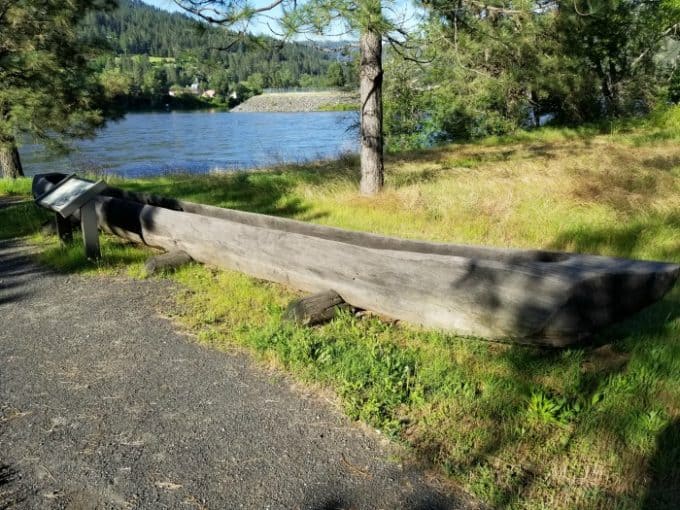The Lewis and Clark National Historic Trail is approximately 4,900 miles long, extending from Wood River, Illinois, to the mouth of the Columbia River, near present-day Astoria, Oregon. Visiting the trail all in one would be quite the adventure.

Lewis and Clark National Historic Trail
The trail connects 11 states Illinois, Missouri, Kansas, Iowa, Nebraska, South Dakota, North Dakota, Montana, Idaho, Washington, and Oregon, and many Tribal lands. Below is a list of sites that can be visited along the trail. Among the more than 100 sites along with the Lewis and Clark National Historic Trail, only five are National Park Service sites. While there is no fee to visit the trail there may be fees charged at some of the individual sites along the trail that are run by other agencies.
The Lewis and Clark Expedition traveled from Illinois to the Pacific Ocean and back between 1804 and 1806. The trail was established by Congress in 1978 as part of the national trails system (NTS) as one of four original national historic trails.
The Lewis & Clark National Historic Trail unveiled the ultimate online trip-planning portal, lewisandclark.travel. The portal, which is designed to help visitors learn more about the host communities, local businesses, and attractions located along the 4,900-mile trail which runs from Pittsburgh, Pennsylvania, to the Pacific Ocean. Through the portal’s interactive map guide, travelers can plan themed trips and locate recommendations for lodging, historic places, sustainable communities, natural areas, and tribal lands.
The Lewis and Clark National Historic Trail, administered by the NPS, is more than 4,900 miles long, traversing 16 states and many tribal lands, and follows the historic route of the Lewis and Clark expedition. The Lewis and Clark National Historic Trail was designated by U.S. Congress to commemorate the 1803 to 1806 Corps of Discovery Expedition to explore the newly acquired western portion of the United States and ensures this historic expedition is commemorated through the identification, preservation, and interpretation of the Trail route, all while ensuring public use and enjoyment. This epic journey contributed significant scientific knowledge and profound political, social, economic, cultural, and environmental changes to the peoples and landscapes of the North American continent.
The trail has over 6,600 miles of the designated auto tour route, which provides visitors access to the historic route through rich recreational, interpretive, and educational opportunities. Many segments of the Lewis and Clark National Historic Trail retain landscape characteristics and a sense of place as seen and experienced by the original Lewis and Clark expedition. The trail links contemporary authentic communities and cultures, including tribes whose connections span thousands of years, to historic, vibrant, and living landscapes. Whether traveling the entire length of the trail or a short day trip to a small segment, the travel experience can be greatly enhanced by the amazing possibilities highlighted on the new online portal.
List of sites you can visit on the Lewis and Clark National Historic Trail
- Preparing for the Journey
Monticello (Virginia) - Harpers Ferry National Historical Park (West Virginia)
- American Philosophical Society Hall (Pennsylvania)
- Big Bone Lick State Park (Kentucky)
- Old Clarksville Site (Kentucky)
- Fort Massac Site (Illinois)
The Expedition
- Old Cahokia Courthouse (Illinois)
- Jefferson National Park (Missouri)
- St. Charles Historic District (Missouri)
- Tavern Cave (Missouri)
- Rocheport Historic District (Missouri)
- Arrow Rock (Missouri)
- Fort Osage (Missouri)
- Leary Site (Nebraska)
- Fort Atkinson (Nebraksa)
- Sergeant Floyd Monument (Iowa)
- Spirit Mound (South Dakota)
- Knife River Indian Villages National Historic Site (winter of 1805) (North Dakota)
- Big Hidatsa Village Site (North Dakota)
- Fort Union Trading Post National Historic Site (North Dakota)
- Lewis and Clark Camp at Slaughter River (Montana)
- Great Falls Portage (Montana)
- Tower Rock (Montana)
- Three Forks of the Missouri (Montana)
- Beaverhead Rock-Lewis and Clark Expedition (Montana)
- Lemhi Pass (Idaho and Montana)
- Clark's Lookout, August 13, 1805 (Montana)
- Traveler's Rest (Montana)
- Lolo Trail (Idaho and Montana)
- Weippe Prairie (Idaho)
- Rock Fort Campsite (Oregon)
- Cape Disappointment Historic District (Washington)
- Chinook Point (Washington)
- Fort Clatsop National Memorial (winter of 1806) (Oregon)
- Lewis & Clark Trail--Travois Road (return trip) (Washington)
- Nez Perce National Historical Park (Idaho and Montana)
- Pompey's Pillar (return trip) (Montana)
- Camp Disappointment (return trip) (Montana)
- Two Medicine Fight Site (return trip) (Montana)
After the Expedition
- Locust Grove (Kentucky)
- Natchez Trace Parkway
**Sites are listed chronologically.
Things to know when planning a visit along the Lewis and Clark National Historic Trail
Lewis and Clark National Historic Trail Headquarters and Visitor Center
601 Riverfront Drive
Omaha, NE 68102
Contact Trail headquarters by phone at (402) 661-1804
The visitor center is closed on weekends in the winter and on Thanksgiving, Christmas and New Years Day
There is no fee to travel the Lewis and Clark National Historic Trail.
Lewis and Clark NHT Junior Ranger Program
You can complete the Lewis and Clark NHT Junior Ranger Program at home. There are 20 questions on the Junior Ranger page to fill out and then mail into the national park. You can find the info on this page.
Learn more about National Park Passes for parks that have an entrance fee.
$80.00 - For the America the Beautiful/National Park Pass. The pass covers entrance fees to all US National Park Sites and over 2,000 Federal Recreation Fee Sites for an entire year and covers everyone in the car for per-vehicle sites and up to 4 adults for per-person sites.

Buy your pass at this link, and REI will donate 10% of pass proceeds to the National Forest Foundation, National Park Foundation, and the U.S. Endowment for Forestry & Communities.
National Park Free Entrance Days -Mark your calendars with the five free entrance days the National Park Service offers annually.
Make sure to follow Park Ranger John on Facebook, Instagram, Pinterest, and TikTok





Leave a Reply